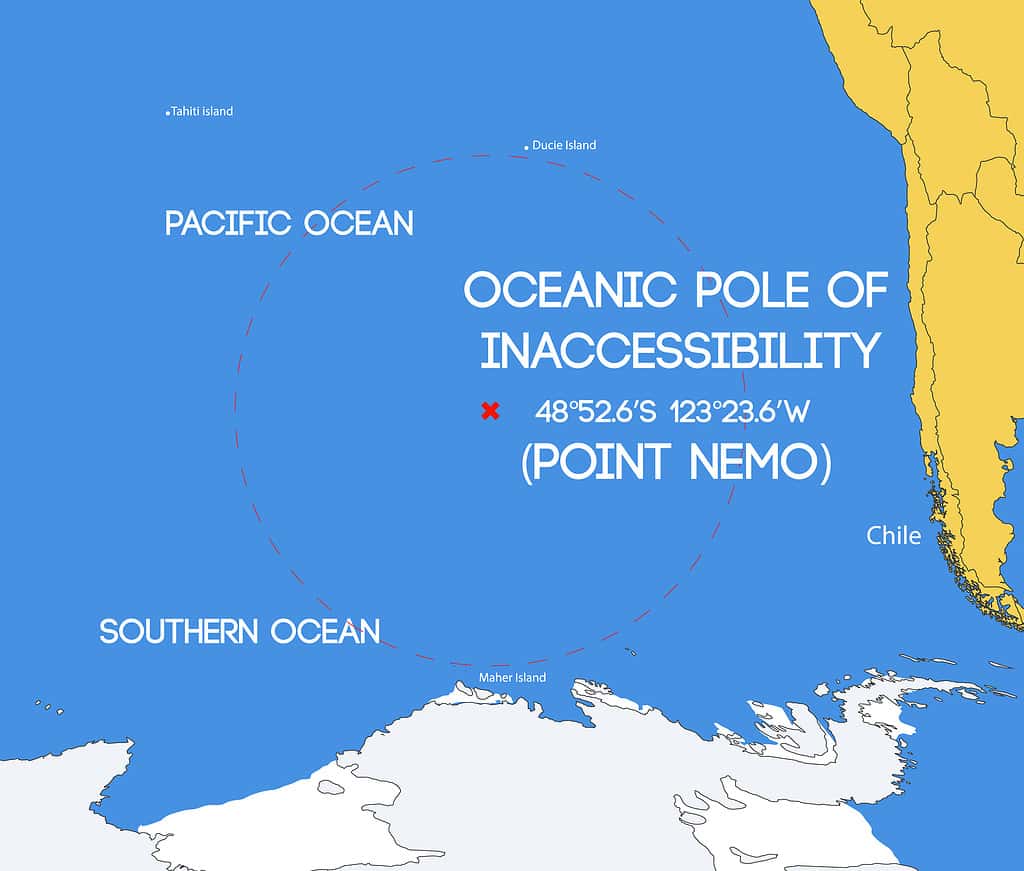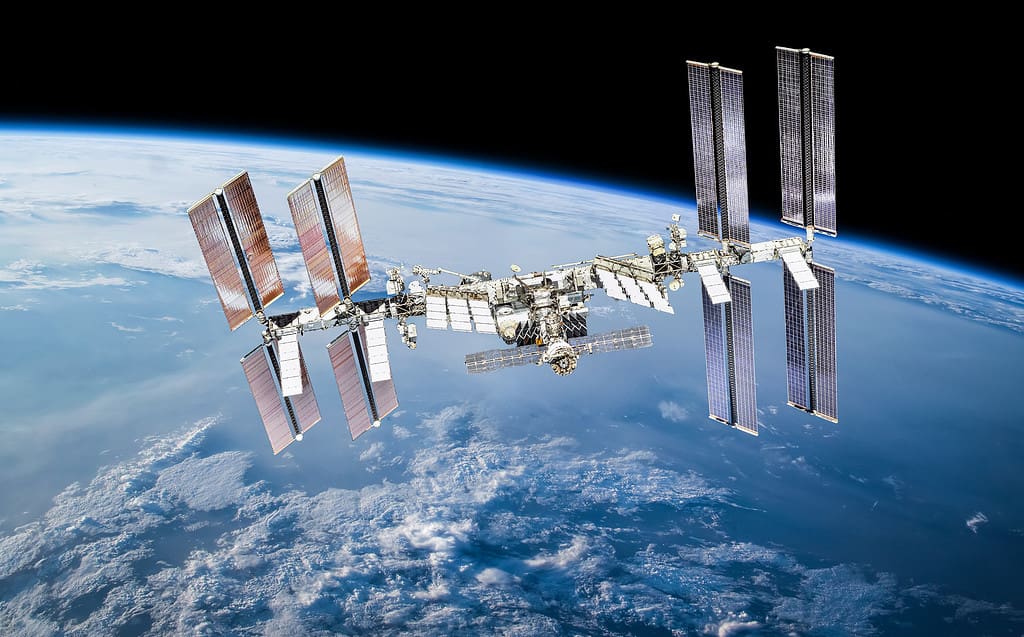The most isolated place on Earth is in the Pacific Ocean. Where is it, and does anything ever happen out there? We’ll discover the most remote spot in the Pacific Ocean and what you will find there now.
What Is the Most Remote Spot in the Pacific Ocean?

The most remote spot in the Pacific Ocean is Point Nemo.
©Main_sail/iStock via Getty Images
Point Nemo is the most remote spot in the Pacific Ocean. It is so remote that it’s probably never been visited by a human being ever. No commercial expeditions traverse the oceanic expanse to get there because there is nothing to see.
Where Is the Most Remote Spot in the Pacific Ocean?
Point Nemo is located in the South Pacific. The closest landmasses are Ducie Island to the north, Motu Nui to the northeast, and Maher Island to the south. Each of these islands is around 1670 miles away from Point Nemo.
Ducie Island is part of the Pitcairn Islands which are a British territory. Motu Nui to the northeast is the most western part of Chile, and it’s just south of Easter Island. Maher Island belongs to Antarctica.
Why Is It the Most Remote Spot in the Pacific Ocean?
Since Point Nemo is the spot in the ocean that’s furthest away from any land, it is called the Oceanic Pole of Inaccessibility. Since there is no nearby land, there is no one living within an area of over 13.5 million square miles around Point Nemo. The nearest landmasses are about 1670 miles away.
Point Nemo: What Are the Coordinates For the Most Remote Spot in the Pacific?
Point Nemo’s exact coordinates are 48°52.6′ south latitude and 123°23.6′ west longitude. A Croatian engineer named Hrvoje Lukatela used computers to pinpoint the most remote spot in the Pacific in 1992.
Lukatela graduated from the University of Zagreb in 1971 after studying geodesy. After graduation, he took a job with IBM where he received comprehensive training in early data processing.
After moving to Canada and embarking on many professional trajectories related to computer programming and geodetic surveying, Lukatela was encouraged to perform an academic exercise. This exercise was determining the most remote point in the oceans on Earth. As a result of this academic exercise, calculations concluded that Point Nemo is the most remote spot in the Pacific Ocean.
Who Is Closest to the Remote Spot of Point Nemo?

The people closest to Point Nemo are sometimes the astronauts on the International Space Station.
©dima_zel/iStock via Getty Images
The living humans that travel closest to Point Nemo are the astronauts aboard the International Space Station. This is because their position when they pass overhead puts them a little under 300 miles away from Point Nemo.
Easter Island, at around 2200 miles away, is the closest point of human civilization to Point Nemo on land. The next center of human life on the surface of the planet available to those on Point Nemo is New Zealand. New Zealand is about 2500 miles away from Point Nemo.
What Will You Find at Point Nemo?
At Point Nemo, you’ll find ocean water, and that’s about it. There isn’t much life there, and anything human-made has slipped below the ocean’s surface. Since the ocean is about 13 thousand feet deep at Point Nemo, seeing sunken debris from the surface is impossible.
There are detected microplastics polluting the water at Point Nemo despite it being the most remote spot in the Pacific Ocean. According to scientists, there are at least 9 microplastic particles per cubic foot in the water. Surprisingly, human pollution has made its way into places on the globe furthest from any signs of civilization.
Wildlife at Point Nemo

Yeti crabs live near hydrothermal vents over 10 thousand feet below Point Nemo.
©Andrew Thurber, Oregon State University, CC BY-SA 2.0, via Wikimedia Commons – License
Almost nothing lives at Point Nemo. That’s because ocean currents in the area are weak, and its remote location makes it inaccessible to most lifeforms. As a result, scientists believe not much has evolved in the area.
This area of the South Pacific is known as the South Pacific Gyre, and Point Nemo sits at the center of it. As a result of an absence of nutrients, the South Pacific Gyre is considered the biggest ocean desert on Earth.
Despite being one of the most desolate spots in the ocean, life exists over ten thousand feet below Point Nemo. On the bottom of the ocean beneath Point Nemo, yeti crabs and the bacteria they eat eke out an existence. They can do this because there are volcanic vents that allow for an extremophile existence.
On the ocean floor, 2 tectonic plates are moving away from each other. This has given rise to hydrothermal vents between the two plates.
Cold ocean water sinks into the gaps between the tectonic plates where it is heated by magma. It is then pushed out of the volcanic vents. As a result, this hot water contains the minerals needed to feed the bacteria that the yeti crabs consume.
Space Junk at Point Nemo
Underneath Point Nemo lies space debris. Human-steered objects from space are often sunk at Point Nemo to avoid any negative effects from potential debris fields on landmasses on Earth. For example, the Russian Mir space station crashed into Point Nemo when it was decommissioned.
Because Point Nemo has been the resting place for so much space debris, it is called the Spacecraft Cemetery. Over 260 spacecraft have purposefully crashed into Point Nemo and disappeared beneath the Pacific Ocean.
In 2024, there is a high probability that the International Space Station will start being decommissioned. If this occurs, Point Nemo is where NASA will deposit it by 2031.
Most of the decommissioned space debris that has crashed into Point Nemo busted apart during re-entry. As a result, it doesn’t sit untouched on the ocean floor, and a huge debris field sits in the area.
The Bloop: What Was the Noise Scientists Heard at Point Nemo?
In 1997, oceanographers heard strange noises that seemed to emanate from Point Nemo. These sounds were picked up by a hydrophone array operated by the U.S. National Oceanic and Atmospheric Administration.
Since human exploration has yet to tackle around 95 percent of the ocean, theories ran riot for decades about what The Bloop could have been. Some thought it may have been secret military drills, mysterious underwater ships, winches from unidentified fishing boats, whales, huge squids, and even as yet unidentified sea monsters.
To this day, no one is sure what The Bloop was. However, it’s now widely accepted that the noises were probably from breaking icebergs occurring during an icequake near Antarctica.
The photo featured at the top of this post is © CurtisC Photoography/iStock via Getty Images
Thank you for reading! Have some feedback for us? Contact the AZ Animals editorial team.






